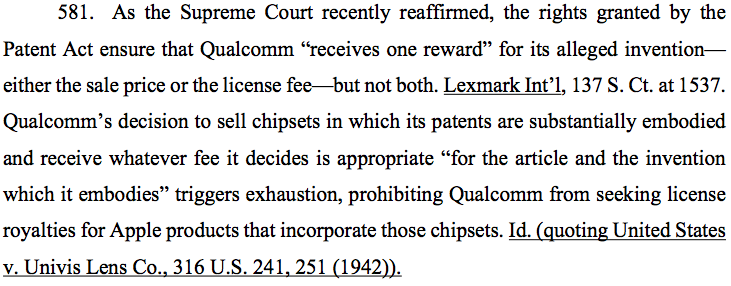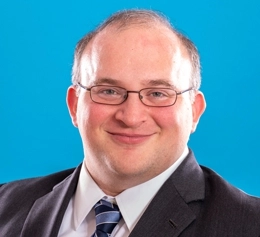Back in January, Patent Progress wrote about lawsuits filed against Qualcomm by the FTCU.S. Federal Trade Commission. An independent regulatory agency charged with consumer protection and competition policy, which conducted several influential studies on how patents work in practice. Authored several key studies: 2003’s To Promote Innovation: The Proper Balance of Competition and Patent Law and Policy [PDF] and 2011’s The Evolving IP Marketplace: Aligning Patent Notice and Remedies with Competition [PDF]. and by Apple. Today, Apple filed an amended complaint against Qualcomm, based in part on new law resulting from the Supreme Court’s Lexmark decision on patent exhaustion.
A High Water Lexmark In Patent Exhaustion
The Lexmark case, while important, is actually really easy to understand. It sets out a very simple rule:
Once you’ve sold a patented product, you can’t use your patent against the purchaser of that product, or anyone they sell it to.
You can still sue someone who buys your product if they use your patent separate from your product, but not if they use the patent by using your product, or making something that includes your product.[1. You could also try to sue them if they breach a contract, such as if the buyer signs a contract agreeing not to resell the chips. But it won’t be patent infringement, just a contract dispute.] But, according to Lexmark, “once a patentee sells an item, it has ‘enjoyed all the rights secured’ by that limited monopoly.” This all goes back to the common law rule against “restraints on alienation”—we don’t like it when people can’t freely use and resell goods they’ve purchased. It’s the same rule with respect to patents. Once you’ve sold it, you’re done. You’ve “exhausted” your rights.
Double-Dipped Patents
Qualcomm, infamously, has not abided by this rule in the past. Instead, they sell their chips (which implement their patents) and then tell the buyer they still have to license Qualcomm’s patents. They double-dip; one reward on sale of the chip, and then another reward for the patent license. And that’s exactly what the Lexmark opinion says you can’t do. Once Qualcomm sells those chips, they can’t go back to the buyer and say “Oh and by the way you still have to pay me for my patents.” That’s been part of Apple’s case from the start, and after the Lexmark decision this issue has only become more important.
Apple’s amended complaint makes the issue quite clear:

Qualcomm can’t, after Lexmark, ask for an additional license from the buyers of its chips.
Qualcomm’s Piece Of The Pie
It seems like this shouldn’t matter. Won’t Qualcomm just raise their price for their chips by the amount of their license so that they receive the same amount, just in one go?
The problem is, Qualcomm doesn’t have a flat license fee for their patents. Instead, they charge a license that’s based on a percentage of the price of the phone.

So Qualcomm might charge $10 (2.5%) for a $400 mid-range smartphone, but charge $15 for a $600 flagship smartphone. (And they might only charge $5 for a low-end $200 smartphone.) They price-discriminate, forcing some people to pay more than others. That puts them in a bind. If they charged $25 for a baseband chip before, plus the license fee, what do they charge now? If they ask for $30, then they’re losing money they were making before. But if they charge $40, then the chips they used to sell for mid-range and low-end smartphones might not sell anymore.[2. This approach has always been questionable. Imagine if I had a patent on the steering wheel. Now imagine that I ask for 0.5% of the sales price of the car for using my wheel. That might be $75 on a subcompact and $750 on a luxury sports car. For the same steering wheel, doing the same thing! It’s a questionable approach in licensing, and it’s just as questionable when patent holders try to use it in court to get damages based on the entire price of an item, not the price of the part that actually implements the patent.]
That might seem unfair to Qualcomm. But that’s exactly what Qualcomm promised they would do when their patents became part of the cellular standards.
Qualcomm’s Actions Are SEPtic And UnFRANDly
Qualcomm’s patents are (according to Qualcomm, at least) “standard-essential patents” (SEPs). A few years back, Patent Progress published an excellent primer on SEPs and how they fit into litigation between smartphone makers.[3. Dan did leave out my favorite SEPStandard-Essential Patent. A patent that a participant in standards development process declares to be essential to the practice of the standard. abuse case, Qualcomm v. Broadcom. Qualcomm sued Broadcom for infringing on two Qualcomm patents. Broadcom fought back, saying that Qualcomm’s patents were unenforceable because Qualcomm had helped develop the relevant standard and never disclosed their patents from the same timeframe. Qualcomm, for their part, claimed they hadn’t participated in the development of the standard. The case went on for years. There were depositions, documents were produced, Broadcom repeatedly asked Qualcomm to produce evidence relating to participation in the standard-setting process. And Qualcomm repeatedly denied ever participating, produced no documents, and their witnesses all testified that there was no participation.
Fast-forward to trial. Qualcomm continues to deny participating, and their witnesses testify that they hadn’t. This went on until the very end of the trial. It’s one of the last couple days of trial. A Qualcomm witness was on the stand. And they admitted to knowing about 21 emails from standards participation.
At which point, to use a legal term, all hell broke loose.
After spending years denying they had participated, it turns out that Qualcomm had participated extensively, sending employees and contractors to meetings and making decisions. And after spending years denying they had any documents, they produced 210,000 pages of emails and documents related to standards participation. Ultimately, Qualcomm and its lawyers were sanctioned and the patents declared unenforceable.
I’m not normally an advocate for reading legal documents just for fun. But the Qualcomm sanction order is worth a read to see just how extensive the misconduct was.]
Part of the deal with an SEPStandard-Essential Patent. A patent that a participant in standards development process declares to be essential to the practice of the standard. is that, in exchange for your patent being in the standard, you have to license your patent on Fair, Reasonable, And Non-Discriminatory (FRAND"Fair, Reasonable, and Non-Discriminatory" licensing. A licensing commitment made for standard-essential patents in the context of technology standard setting activities. See also RAND.) terms. At the simplest, this means you can’t charge an unreasonable amount, can’t abuse your power as a patent-holder, and have to license anyone who asks for a license.
Qualcomm isn’t abiding by any of those commitments.
Qualcomm charges an unreasonable amount. They charge more than their product is worth, depending on how much you plan to sell your product for. Imagine if Walmart charged you $1 for a pen if you were going to do a crossword with it, but $100 if you were going to sign an apartment lease with it. No one would think that’s reasonable, but that’s exactly what Qualcomm does.
Qualcomm abuses its power as a patent-holder. Even though their rights over their patents end when they sell their chips, Qualcomm forces handset makers to take a license to their patents.
And Qualcomm doesn’t license anyone who asks for a license; they won’t license anyone who might try to compete with them. In other words, they discriminate.
Discrimination
Apple refers to this issue obliquely in its complaint, but a couple other companies have made the point a lot more strongly in filings in the FTC’s lawsuit against Qualcomm. In particular, Intel and Samsung point out that Qualcomm refuses to license their competitors, even though FRAND"Fair, Reasonable, and Non-Discriminatory" licensing. A licensing commitment made for standard-essential patents in the context of technology standard setting activities. See also RAND. requires that they do so.
Intel is Qualcomm’s major competitor in the baseband chipset market. (This might be one reason that Qualcomm is starting to make x86 processors that would compete with Intel’s.) But Qualcomm refuses to provide Intel with a license, despite their obligation to negotiate one. This means that Intel can’t provide its customers with a license to the necessary patents—they have to negotiate it with Qualcomm. Which means that Intel loses any pricing control over their product and in fact won’t even know the ultimate price customers are paying. It allows Qualcomm to raise their license price and lower their chipset price in order to drive Intel’s product off market while maintaining their own profits.
Samsung is, in some ways, in an even worse position. Everyone’s familiar with Samsung’s handset business. But Samsung is also a leading chip manufacturer. They make everything from memory to the processors for Apple iPhones. Samsung also makes a portion of Qualcomm’s chips for Qualcomm. And Samsung makes their own baseband chips for some of their phones. They pay Qualcomm a license fee for those chips (which Qualcomm allows them to take, because they’re the handset maker).
Samsung could be interested in selling their own baseband chips to other handset makers, but like Intel, Qualcomm won’t license them to build chips to sell. And Samsung would run an even larger risk if they tried. Intel doesn’t make handsets, but Samsung does. If Samsung became a competitor of Qualcomm, rather than just a customer, Samsung runs the risk that Qualcomm would both refuse to give Samsung a license and refuse to sell Samsung chips.
Qualcomm’s practices have helped ensure that Qualcomm didn’t have to face any real competition. And that let them charge unreasonable amounts for their chips and patents.
What Now?
All of Qualcomm’s actions to date have been taken in the world before the Supreme Court decided Lexmark. Now, they’re going to be faced with an inability to price-discriminate and an inability to require their chip customers to take licenses. That might be enough for handset makers, going forward, since they won’t be forced to pay a license fee to Qualcomm based on a percentage of handset sale price.
But Qualcomm could still refuse to license their patents to competitors, violating their obligations under FRAND"Fair, Reasonable, and Non-Discriminatory" licensing. A licensing commitment made for standard-essential patents in the context of technology standard setting activities. See also RAND.. And that refusal to license will still harm competition in the cellular chipset market, allowing Qualcomm to continue their monopoly in violation of unfair competition laws and their FRAND"Fair, Reasonable, and Non-Discriminatory" licensing. A licensing commitment made for standard-essential patents in the context of technology standard setting activities. See also RAND. obligations. Even after Lexmark, the Apple and FTCU.S. Federal Trade Commission. An independent regulatory agency charged with consumer protection and competition policy, which conducted several influential studies on how patents work in practice. Authored several key studies: 2003’s To Promote Innovation: The Proper Balance of Competition and Patent Law and Policy [PDF] and 2011’s The Evolving IP Marketplace: Aligning Patent Notice and Remedies with Competition [PDF]. suits against Qualcomm remain important.

